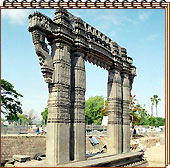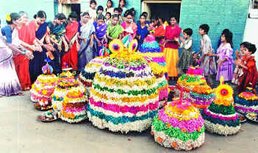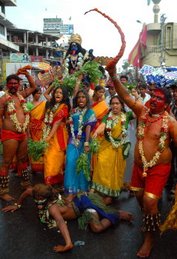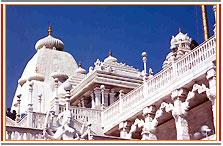Wednesday, November 22, 2006
Telangana History and Facts
Telangana region has been ruled by many great dynasties like Sathavahanas, Chalukyas, Kakatiyas, Mughals, Qutubshahis, asafjahis. Of which the Kakathiyas impressions on architecture are found more in these days too. Sathavahanas ruled over the Telangana for about 400 years from the 2nd century B.C. to beyond the 2nd century A.D. Sathavahanas were also called Salivahanas and Satakarnis. In the 3rd century B.C., Simukha, the founder of the Sathavahana dynasty, unified the various Andhra principalities into one kingdom and became its ruler (271 B.C. -- 248 B.C.).Satakarni II, the sixth ruler of the dynasty (184 B.C.) was an able ruler who extended his kingdom to the west. He ruled for a period of 56 years. Pulumavi I has brought renewed strength and glory to their kingdom. The only silver lining in this dynasty was the excellent literary work, Gathasaptasati, of Hala, the 17th Satavahana king. Dharmapuri in Karimnagar was the capital city for many years.
Among Kakathiyas , Prataparudra, grandson of Rudramamba was great ruler who succeeded his grandmother in A.D.1295 and ruled till A.D.1323. He pushed the western border of his kingdom up to Raichur. He introduced many administrative reforms. He divided the kingdom into 75 Nayakships, which was later adopted and developed by the Vijayanagara Rayas.
During the reign of Bahamani sultan Mohd Shah III, one sultan Quli Qutub, who was born at Hamadan in Persia, came to Deccan and started his career as a bodyguard of Mohd Shah. With his ability and courage he rose from one position to another till he became the Governor of Telangana, the eastern province of Bahmani kingdom.
When the Bahamani sultanate became weak, Quli Qutub became independent and formed his Qutubshahi Dynasty in 1518. From then, he devoted most of his energies in extending his frontiers of his kingdom. He took possession of part of Berar in the north, Rajkonda, Deverkonda, Gahanpura, Kovilakonda and Panagal thus brought much of Telugu speaking areas in to his possession. He defeated Sitapati of Bhogikala, and captured Bellamkonda, Indrakonda, Khammam, Warangal etc. in 1543 Jamsheed assassinated Quli Qutub.
The Golkonda fort was built by Quliqutub. His son Jamsheed became the King who was succeeded by his brother Ibrahim in 1550 .During his reign, trade and commerce flourished enormously. Telangana, like Egypt, became the Mart of the whole world. Merchants from Turkistan, Arabia and Persia used to frequent Telangana and found their trade attractive and prosperous. In his reign two tanks namely Ibrahim Pantam tank and Hussainsagar were built. He also built a bridge on river Musi, which is known as Puranapul. The Hindus of Telangana remember him for his patronage of Telugu literature. Many Telugu poets like Addanki Gangadher Kavi, Panuganti Telanganarya, Kandukuri Rudra Kavi flourished in his court. He gained goodwill among his Hindu subjects. He died in 1580, and was succeeded by his son Quli Qutub Shah.
Qutubshah shifted his capital from Golkonda to Hyderabad on the river Musi. He built the Jamia mosque at Charminar. He died in 1611. He was succeeded by his nephew Mohd. Qutubshah as he had no sons. Mohd Qutub Shah joined the confederation of Deccani powers against Moughals to stop their advance towards Deccan/South. He was a scholar and composed gazals, tarki, bunds and rubaya. He died in 1662, and was succeeded by his son-in-law Sayyed Ahmed in 1667.
At this time the Moughals annexed Ahmednagar and marched towards Golkonda. Sayyed Ahmed signed the treaty, and accepted the suzerainity of Moughal emporer Shah Jahan and agreed to pay 8 lakhs of rupees as tribute to Moughlals.
With the connivance of mirjumla the Mughal Emperor Aurgangzeb sent his son Mohd. Sultan in 1656, who besiezed Golkonda and occupied Hyderabad. However on intervention of Darashekou and Jahanara from Delhi, Aurangazeb was compelled to raise the seize on payment of one crore and to surrender Chinnoor. Later Mohd Sultan married the second daughter of Abdullah. Abdullah died in 1672 and his son-in-law Abul Hassan succeeded him. He appointed Madanna as his Prime Minister and his brother Akkanna as commander in chief. In 1687 Auragazeb again attacked Golkonda which successfully resisted -his advance. But due to treachery of Sardar Khan a high officer in the Army who opened the gate of Golkonda fort, captured the fort in 1687 and Abul Hassan was made captive. They looted the city in every street and market place where lakhs worth in cash, property, chinaware and costly carpets of aristocracy was available.
The State of Hyderabad was founded by Mir Qamruddin Chin Qilich Khan. He was the son of Aurangzeb's general . Ghazi-ud-din Khan Feroz Jang, who traced his ancestry to Abu Bakr, the first Khalifa. In 1713, six years after Aurangzeb's death, emperor Farrukhsiyar made Mir Qamruddin Viceroy of the Deccan, with the title of Nizam-ul-Mulk Feroz Jang. Later, emperor Muhammad Shah conferred on him the title of Asaf Jah, by which title the dynasty is still known. By 1724, Mir Qamruddin had made himself virtually independent of Delhi, although he and his successors continued to profess a nominal allegiance to the Moghul emperor right up to 1858, when the British Crown assumed the governance of India.
In 1799 the Nizam aided the East India Company in the war with Tippu Sultan and after the latter's defeat and death, the British gave a part of his territories to the Nizam.
The death of Nizam All Khan and the succession of his eldest surviving son, Sikander Jah, occured on 7 August 1803.
Sikander Jah died on 21 May 1829, and was succeeded by his eldest surviving son, nasir-ud-Daula. By the Treaty of 1853, the province of Berar, along with certain districits in the Raichur Doab and on the wertern frontier of Hyderabad, were assigned for this purpose, their administration being taken over by British officers under the control of the Resident at Hyderabad.
By the Treaty of 1860, except for Berar, all the other districts assigned in 1853 were restored.
Mir Mahbub Ali Khan was a minor when he succeeded his father afzal-ud-Daula on 26 February 1869.
The Hyderabad contingent with the exception of the artillery which was disbanded, was delocalized and incorporated in the Indian Army, with provision for the protection of the Nizam's dominion.
Nizam Mir Usman Ali Khan Bahadur is the seventh in the line. He succeeded to the gaddi on 29 August 1911. In 1918 the title of "is Exalted Highness" was conferred on him as a hereditary distinction. Shortly thereafter, by an autograph letter from the King, he was granted the title of 'Faithful Ally of the British Government.'
Geographically, Hyderabad occupies a pivotal position in the heart of the country. In population, revenue and importance it was the premier State in the country. The population was nearly sixteen million and the annual revenue Rs. 26 crores. Its area was over 82,000 square miles. Hyderabad had its own coinage, paper currency and stamps. Hyderabad was treated by the British no differently from other Indian States. The right of intervention in internal affairs was repeatedly asserted and exercised.
In 1885 Reading, then Viceroy, ascertained that the sovereignty of the British Crown was supreme in India. The Viceroy pointed out that it was the right of the British Government to intervene in the internal affairs of Indian States, and that the Nizam did not stand in a category separate from that of rulers of the other Indian states.
In March 1946 the cabinet mission advised the princely states regarding the future of their merger after the formation of independent India, and separate Pakistan for Indian Muslims. This was further clarified in May 1946 referring to the lapse of paramountency and formation of federation. The congress opposed the Independent states outside the Federal Union, but the Muslim league was encouraging the states to remain Independent. Nizam of Hyderabad was under the influence of a fanatical body called Ittehadul Musulmin under Kasim Razvi, declared his intention to remain as independent state.
Soon after the announcement of His Majesty's Government's plan of 3 June 1947, the Nizam issued a firman declaring his intention not to send representatives to the Constituent Assembly of either Pakistan or India, and making it clear that on 15 August he would be entitled to resume the status of an independent sovereign. It had been his ambition to secure Dominion Status for his State, on the withdrawal of the British and treatment then henceforth as a member of the British Commonwealth of Nations. When he saw that clause 7 of the Indian Independence Bill did not permit that grant of Dominion Status to an Indian State. The Nizam sent a delegation to Delhi on 11 July headed by the Nawab of Chhatari, President of the Executive Council, to meet Lord Mountbatten.
Meanwhile Laik Ali was pressing that the Hyderabad issue should be taken to the United Nations Organization. On 17 August, he wrote to Nehru that Hyderabad had decided to solicit the good offices of the United Nations Organization in order that the dispute between Hyderabad and India might be resolved and a peaceful and enduring settlement arrived at.
The Indian Government did not agree that Hyderabad had any right in international law to seek the intervention of the United Nations Organization or any other outside body for the settlement of the issue. And that as the Government of India regarded the Indo-Hyderabad dispute as a purely domestic one, they did not recognize the Nizam's claim to invoke the good offices of the United Nations in that connation.
The below given are the detailed notes on the history of Ancient,medieval ,modern period of the Telangana region and also the freedom struggle, Razakar Movement and The separate Telangana agitation.
CLICK TO GO TO HOME PAGE
Subscribe to:
Post Comments (Atom)










8 comments:
Gud effors mates
Ji Telangana
i give my poem
vidyarthulu vasthunnaru, gunta nakkallaraa , baaagooo,
KCR, Picchasupatri ki anduko mari paruguuuuu.
SHOCK LU PETTANDI, VAANIKI MANCHI BUDDI VACCHE VARAKU
INKA TRS WALO CHAVANDI !! thaagi Muchukundaa nadi MURUGU.(Muchukundaa= moosi)
inspired from samanaydu anna s poetry.
http://saamaanyudu.wordpress.com
TELANGAN LAU ANDRA HATHAO KCR IS OUR HERO TELANGANA IS OUR NOT ANDHRA, TELANGANANU DOCHU KUNNADI CHALU, IKA MAKU MADI IVVANDI ANDHRA WALLA KU ENGILI METHKULU THINEY ALAVATHU CHALA UNNADI, ANDUKEY SMAKY ANDHRA ANTUNNARU LAGADA KU MATHI THAPPI POINDHI WADU MENTAL AYADU TELANGANAN NU DOCHU KUNNADI SARY POLEDU ANDUKEY ANTHA THAPANA, TELANGANA KU ADDU WASTHEY IKA HUD LO ANDHROLLU KANA BADARU - JAGRATHA - JAI TELNAGANA JAI JAI TELNAGAN
i request to our muslim camunity please save our hyderabad i will fight for telanagana
telanaga is our oldest city o
Jai Telangana...great efforts..every one should know the reasons why we are fighting for telangana...no compromise on self respect..definitely we will win..
Dear All,
Please see the FACTS based on RTI act and other sources... And decide what you will do Support the great cause of Telangana or not??
Districts – Telangana – 10 – Andhra – 09 – Rayalaseema – 04 (So called 'Samaikya Andhra' total = 13 districts)
Education
^^^^^^^^^
1.Schools - Telangana – 17,594 – Andhra – 26,800 – Rayalaseema – 13,001
2.Junior Colleges - Telangana – 176 – Andhra – 270 – Rayalaseema – 140
3.Degree Colleges - Telangana – 74 – Andhra – 170 – Rayalaseema – 70
Total money spent on Education till now (in Crores)- Telangana – 16,339 – Andhra – 1,30,856 – Rayalaseema – 38,247
Literacy Rate - Telangana – 30% – Andhra – 42% – Rayalaseema – 38% (total 'Samaikya Andhra' is 80%)
Injustice:
============
Almost 90% of Junior colleges are run by so called 'Samaikya Andhra'. They have literally killed the Junior colleges run by Telanagan ppl, If any educational institute especially Junior colleges run by non Telangana ppl then the exam papers are evaluated in Andhra and they will literally fail the students,however the student done well or pass by <=50% and then they blacklist the colleges
Health
^^^^^^^^^
1.Hospitals(All Types) - Telangana – 270 – Andhra – 666 – Rayalaseema – 303 (total 'Samaikya Andhra' is 969)
Injustice:
============
Famous government hospitals like Gandhi,Osmania and NIMS etc, all medical equipments where purchased on account of Telangana people then next day it would transferred to Andhra and Rayalaseema., See the Telugu news papers of dated of 1999-2000
Employment
^^^^^^^^^^
1.Civil Services - Telangana – 67 – Andhra – 213 – Rayalaseema – 44
2.Judges - Telangana – 39 – Andhra – 84 – Rayalaseema – 15
3.Commercial Tax Officers - Telangana – 161 – Andhra – 418 – Rayalaseema – 42
4.Teachers - Telangana – 66,040 – Andhra – 90,435 – Rayalaseema – 40,552
5.Film Industry - Telangana – 0 heros, 0 heroine (1 - Nitin and 1-Vijayshanti, both were literally out of film industry). All top heros and heroines are from, so called 'Samaikya Andhra'
6.IT Software Companies (in around HITEC City) - Telangana – 76,040 (Mostly BPO) – Andhra – 5,90,435 – Rayalaseema – 2,40,552
7.Police department - Telangana – 4% (Only Constable,HC,SI,ASI Cadre) – Andhra – 84% (Seniors) – Rayalaseema – 12%
8.
Injustice:
============
1.Best MISuse of Referral Scheme by HR/employee by so called 'Samaikya Andhra' to exploite the Telangana people AND not even shortlisted in the interviews based on local resumes.
2.How people in the Telangana given opportunity to setup Software companies???? As on today it is ZERO!!!!!!!
----------------------------------------------------------------------------------------------------------
As per Girglani Report there are about 2,50,000 Non-Telangana people employed in Telangana govt jobs.
=======================================================================================================
Industries - Telangana – 1253 – Andhra – 6054 – Rayalaseema – 773
Electricity consumption - Telangana – 23% – Andhra – 54% – Rayalaseema – 23%
River water utilisations
^^^^^^^^^^^^^^^^^^^^^^^^^^^^^^
Godavari associated area - Telangana – 79% – Andhra – 21% – Rayalaseema – Nil
Godavari water utilization - Telangana – 09% – Andhra – 91% – Rayalaseema – Nil
See the difference -- Godavari cross across the Telangana region ie., 79% but it gets only 9%
Krishna associated area - Telangana – 69% – Andhra – 13% – Rayalaseema – 18%
Krishna water utilization - Telangana – 13% – Andhra – 65% – Rayalaseema – 22%
Dear rsrini2009,
If 91% of Godavari water is being used by Andhra and 9% is used by telangana, it makes 100%. Which means no water is going in to sea.
If you have any proof through RTI act kindly publish here, so that Seemandhra people will also support you for Telangana State.
Any many figures mentioned by you were of Prof.Jayashankar which do not have a valid proof. His book was written before the RTI act implementation.
A simple logical question to you....
How can a region(Telangana) which is robbed, neglected, supressed for 50 years can have high income than other regions?
Post a Comment